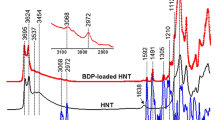Abstract
In this present paper, melamine cyanurate (MCA)/aluminum diethylphosphinate (AlPi) were used as composite flame retardants, and with addition of graphene (Gr) served as thermal conductive filler for preparing flame-retardant and thermal conductive polyamide 66 (PA66). The effects of Gr on flame retardancy, as well as the thermal conductivity on the combustion behavior of PA66 under the heat environment were investigated. The results demonstrated that Gr could effectively inhibit phosphorus-containing radicals from AlPi into gaseous phase and improve its impact on the condensed phase. Additionally, as a physical carbon source, two-dimensional sheets of Gr provide excellent barrier shielding effects and increase the residue, thus significantly retarding the melt drops during the combustion process. The results showed that the specimens with 12 wt% composite flame retardants and 3.5 wt% Gr, passed UL-94 V-0 rating (1.6 mm of thickness) and the total heat release (THR) were decreased by 22% according to micro-scale combustion calorimetry (MCC). Additionally, the improved thermal conductivity due to the addition of Gr, effectively enhances the thermal heat dissipation rate and decreases the risk of self-ignition caused by local heat accumulation.









Similar content being viewed by others
References
Liu Y, Wang Q (2006) Melamine cyanurate-microencapsulated red phosphorus flame retardant unreinforced and glass fiber reinforced polyamide 66. Polym Degrad Stab 91(12):3103–3109
Ma T, Guo C (2017) Synergistic effect between melamine cyanurate and a novel flame retardant curing agent containing a caged bicyclic phosphate on flame retardancy and thermal behavior of epoxy resins. J Anal Appl Pyrolysis 124:239–246
Steven XI, Wei JC, Chen BA et al (2014) Flame retardant effect of melamine Cyanurate on glass Fiber reinforced nylon 66 composites. J Funct Polym 27(4):365–371
Ch LS, Narayana CD, Srinag T et al (2015) An investigation on thermal conductivity of graphite filled PA66 composites. Procedia Eng 127(1):1308–1314
Ren F, Zhou R, Sun F et al (2017) Blocked isocyanate silane modified Al2O3/polyamide 6 thermally conductive and electrical insulation composites with outstanding mechanical properties. RSC Adv 7(47):29779–29785
Li M, Wan Y, Gao Z et al (2013) Preparation and properties of polyamide 6 thermal conductive composites reinforced with fibers. Mater Des 51(5):257–261
Liu T, Li J, Wang X et al (2013) Preparation and properties of thermal conductive polyamide 66 composites. J Thermoplast Compos Mater 28(1):32–45
Colomba DB (1996) Modeling of solid- and gas-phase processes during thermal degradation of composite materials. Polym Degrad Stab 54(2):241–248
Stevanovic A, Mehta S, Walther DC, Fernandez-Pello AC (2002) The effect of fiberglass concentration on the piloted ignition of polypropylene/fiberglass composites. Combust Sci Technol 174(11–12):171–186
Ghosh S, Calizo I, Teweldebrhan D et al (2008) Extremely high thermal conductivity of graphene: prospects for thermal management applications in nanoelectronic circuits. Appl Phys Lett 92(15):1148
Laskar JM, Bagavathiappan S, Sardar M et al (2008) Measurement of thermal diffusivity of solids using infrared thermography. Mater Lett 62(17):2740–2742
Braun U, Schartel B (2010) Flame Retardancy mechanisms of Aluminium Phosphinate in combination with melamine Cyanurate in glass-fibre-reinforced poly (1,4-butylene terephthalate). Macromol Mater Eng 293(3):206–217
Li D, Li T, Wang S et al (2014) Synergistic flame retardancy of aluminium diethylphosphinate and melamine cyanurate in polyamide 6. Mod Plast Process Appl 26(6):34–37
Ramani A, Dahoe AE (2014) On flame retardancy in polycaprolactam composites by aluminium diethylphosphinate and melamine polyphosphate in conjunction with organically modified montmorillonite nanoclay. Polym Degrad Stab 105(7):1–11
Chen Y, Wang Q, Yan W et al (2006) Preparation of flame retardant polyamide 6 composite with melamine cyanurate nanoparticles in situ formed in extrusion process. Polym Degrad Stab 91(11):2632–2643
Zhan Z, Xu M, Li B (2015) Synergistic effects of sepiolite on the flame retardant properties and thermal degradation behaviors of polyamide 66/aluminum diethylphosphinate composites. Polym Degrad Stab 117:66–74
Seefeldt H, Duemichen E, Braun U (2013) Flame retardancy of glass fiber reinforced high temperature polyamide by use of aluminum diethylphosphinate: thermal and thermo-oxidative effects. Polym Int 62(11):1608–1616
Yang L, Han XY, Cheng-Liang B I et al (2011) Preparation of aluminum diethylphosphinate as a novel class of phosphorous based flame retardant. Chem Reagents 33(4):340–336
Chen W, Liu Y, Liu P et al (2017) The preparation and application of a graphene-based hybrid flame retardant containing a long-chain phosphaphenanthrene. Sci Rep 7(1):8759
Keqin D, Jianhong Z, Haowen H et al (2016) Electrochemical determination of nitrite using a reduced graphene oxide–multiwalled carbon nanotube-modified glassy carbon electrode. Anal Lett 49:2917–2930
Keqin D, Xiaofang L, Haowen H (2016) Synthesis of a novel triad hybrid of noncovalent-assembled nickel (II)norcorrole on graphene oxide encapsulated multiwalled carbon nanotubes and its application. Electrochim Acta 204:84–91
Balandin AA, Ghosh S, Bao W et al (2008) Superior thermal conductivity of single-layer graphene. Nano Lett 8(3):902–907
Acknowledgements
The authors acknowledge the financial support from the National Key Research and Development Program of China (2017YFB0309001), NSAF Fund (U183010085), and the Open project of Sichuan Provincial Key Lab of Process Equipment and Control (GK201711),Sichuan Science and Technology Project (No.2019YFSY0011) .
Author information
Authors and Affiliations
Corresponding author
Additional information
Publisher’s note
Springer Nature remains neutral with regard to jurisdictional claims in published maps and institutional affiliations.
Rights and permissions
About this article
Cite this article
Luo, D., Liu, Y., Shi, Y. et al. The properties of flame retardant and heat conduction polyamide 66 based on melamine cyanurate/aluminum diethylphosphinate/graphene. J Polym Res 26, 216 (2019). https://doi.org/10.1007/s10965-019-1866-6
Received:
Accepted:
Published:
DOI: https://doi.org/10.1007/s10965-019-1866-6




